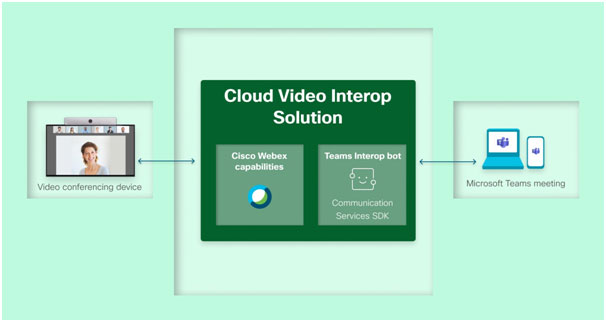A lot of excitement has been generated following the Cisco and Microsoft partnership announcement at Ignite 2022. This is certainly a step in the right direction for the Enterprise which desires to get the most from their existing on-premises meeting-room investment. But what does this mean for a UC Agnostic Enterprise?
Whilst client focussed organisations may standardise on a single tool for Real-Time-Communications internally, they still need to cater for meetings hosted on an alternative platform and expect a seamless user experience from not only their devices but within the meeting room. For a long time, Cisco Endpoints have been the answer.
The Traditional Solution – CVI, WebRTC and SIP:
Cloud Video Interop (CVI) is a solution that enables third-party meeting rooms and personal video devices to join Microsoft Teams Meetings. There are several Microsoft CVI partners available on the market which provide this interoperability. This is incredibly lucrative for organisations which have a large Cisco Endpoint estate, which are also starting to adopt Microsoft Teams. Your end-users may be familiar with the look-and-feel of Cisco devices, so the ability to join Microsoft Teams meetings from the same platform in a similar fashion (By simply entering your meeting ID) may be the simplest option. However, this of course has some caveats, if you have CVI but need to call another organisations Teams meeting, they also need to have CVI.

Should Calendar services be enabled and configured, you can start educating your users to using One Button to Push (OBTP) This involves forwarding the Microsoft Teams calendar invitation to the Room Mailbox directly and simply pressing “Join” on the Touch Panel.
WebRTC differs from CVI and has several limitations which you must accept (such as no HDMI Ingest). The general concept is that modern endpoints are connecting to meetings from an embedded web browser.
To be truly agnostic using in-room hardware, straight up SIP dialling can be the obvious choice. For example, requirements may rise to be able to communicate with external parties which leverage on-premises Bridges, or simply connecting to BlueJeans/Zoom meetings. This can be achieved very simply and deployed at-scale with the use of UI Extensions and Macros, presenting the user with a very simple choice.
The Cisco User Experience:
The below image is a representation of a Cisco Touch 10/Navigator Panel with Macro’s to present the end-user with options to join Webex, Google Meets, MS Teams or Zoom Meetings.

Should back-to-back group meetings be taking place on various platforms from your meeting spaces, with calendar services enabled, users can be presented with a Join button prior to the call starting. This in turn provides a streamlined and consistent experience, despite the recorded limitations.

Are MTR’s the answer?
It is no secret that Microsoft Teams Rooms (MTR’s) are being heavily adopted across the globe by organisations which have heavily invested in the Microsoft ecosystem. MTR’s are fantastic native devices which provide the ultimate Microsoft Teams experience. Users can have more engaging meetings with the use of Chat/Reactions and so on, but what if you want to continue to provide a consistent user experience when you need to leave the Teams platform?
The answer from Microsoft up until now has been one of two things, BYOD/BYOM (Bring-Your-Own-Device/Bring-Your-Own Meeting) via USB-Passthrough or Direct Guest Join (Re-branded WebRTC capability)
Direct Guest Join services are still expanding, and the feature parity gap is getting smaller between Windows and Android based room-systems, which is a significant challenge for organisations with hundreds to thousands of devices. The general feedback is the quality of this solution is much weaker than what they are used to when compared with CVI or their experience connecting from corporate devices. This is due to video negotiation protocols only supporting standard definition when joining via a browser, but we understand this is being addressed by the vendors from continuous customer feedback.
BYO could potentially be the saving grace, and typically can be accepted and adopted for many organisations. However, this comes with a whole new set of challenges including user-education and training, in addition to having some device security challenges when driving a meeting from your corporate laptop. This is a concept which requires careful planning and consideration or could be a significant IT burden.
So, running Microsoft on existing Cisco Devices, will it fix the problem?
The supported devices from Cisco will essentially run the native Teams Rooms for Android software. A Cisco Cloud Hub connectivity subscription will be required to provide a native WebEx application experience which certainly is brand new to the market. In absence of this license, Direct Guest Join will be used. This is great news for organisations primarily using Teams and Webex, as when Webex meetings are ended on the device, it will revert to the Teams Room experience automatically without user intervention.
The simple answer is that it is very early days. The list of compatible devices is limited, so we can only hope that the certification track is extended across the rest of the Webex Room and Desk suite.
Could it have the potential to create an interoperability revolution? Maybe. We must continue to monitor progress made on Direct Guest Join capabilities, as well as stability and software enhancements made to Android application-base.













